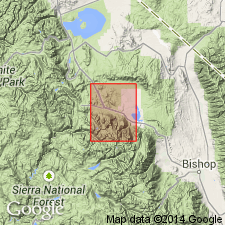
- Usage in publication:
-
- Convict Lake formation*
- Modifications:
-
- Named
- Biostratigraphic dating
- Dominant lithology:
-
- Hornfels
- Sandstone
- AAPG geologic province:
-
- Sierra Nevada province
Summary:
Named for well-exposed rocks near the west end of Convict Lake accessible along the north shore. Type locality near west end of Convict Lake, Mount Morrison 15' quad, Mono Co, Sierra Nevada, CA; exposed from type locality along strike for a mile to north and discontinuously for 4 mi to south. Consists of two members: an upper siliceous calc hornfels (300 ft thick) and a lower siliceous hornfels (1200 ft thick), dark gray to medium-dark gray. Tongue of granodiorite obliterates upper stratigraphic contact. Contains lesser amounts of slate, metachert and marble in lower member. Near Convict Lake lower contact is base of lowest prominent quartz sandstone interbedded with thin beds of marble. Conformably overlies Mount Aggie formation and underlies Mount Morrison sandstone (new). Age, determined by graptolites (identified by R.J. Ross and W.B.N. Berry written commun., 1958) is Middle Ordovician.
Source: GNU records (USGS DDS-6; Menlo GNULEX).
For more information, please contact Nancy Stamm, Geologic Names Committee Secretary.
Asterisk (*) indicates published by U.S. Geological Survey authors.
"No current usage" (†) implies that a name has been abandoned or has fallen into disuse. Former usage and, if known, replacement name given in parentheses ( ).
Slash (/) indicates name conflicts with nomenclatural guidelines (CSN, 1933; ACSN, 1961, 1970; NACSN, 1983, 2005, 2021). May be explained within brackets ([ ]).

